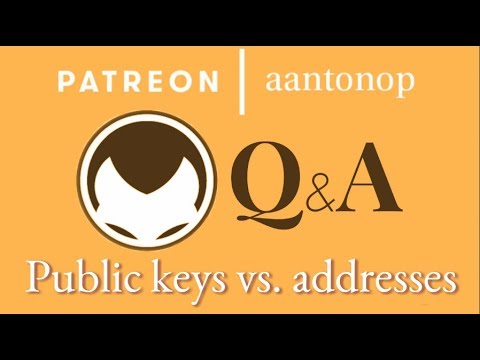What is the difference between public keys and addresses? How are new addresses generated? How are change addresses generated? Why have two outputs? Do you still pay fees if you are sending bitcoin to new addresses in your own wallet? What is the VanityGen command? What does the SIG_HASH flag do?
More from ‘Mastering Bitcoin’: https://github.com/bitcoinbook/bitcoinbook/blob/f8b883dcd4e3d1b9adf40fed59b7e898fbd9241f/ch04.asciidoc
These questions are from the MOOC 9.3 and 9.5 sessions which took place on March 2nd and March 16th, 2018 respectively. Andreas is a teaching fellow with the University of Nicosia. The first course in their Master of Science in Digital Currency degree, DFIN-511: Introduction to Digital Currencies, is offered for free as an open enrollment MOOC course to anyone interested in learning about the fundamental principles.
If you want early-access to talks and a chance to participate in the monthly live Q&As with Andreas, become a patron: https://www.patreon.com/aantonop
RELATED:
Advanced Bitcoin Scripting Part 1: Transactions and Multi-sig – https://youtu.be/8FeAXjkmDcQ
Advanced Bitcoin Scripting Part 2: SegWit, Consensus, and Trustware – https://youtu.be/pQbeBduVQ4I
Reusing addresses – https://youtu.be/4A3urPFkx8g
Airdrop coins and privacy implications – https://youtu.be/JHRnqJJ0rhc
Wealth distribution statistics – https://youtu.be/X2Qsz4eaSPY
Mixing services – https://youtu.be/rKoMvOH4zoY
How do mnemonic seeds work? – https://youtu.be/wWCIQFNf_8g
Using paper wallets – https://youtu.be/cKehFazo8Pw
What is Segregated Witness? – https://youtu.be/dtOjjB4mD8k
Spam transactions and Child Pays For Parent (CPFP) – https://youtu.be/t3c0E4fkSNs
Andreas M. Antonopoulos is a technologist and serial entrepreneur who has become one of the most well-known and respected figures in bitcoin.
Follow on Twitter: @aantonop https://twitter.com/aantonop
Website: https://antonopoulos.com/
He is the author of two books: “Mastering Bitcoin,” published by O’Reilly Media and considered the best technical guide to bitcoin; “The Internet of Money,” a book about why bitcoin matters.
THE INTERNET OF MONEY, v1: https://www.amazon.co.uk/Internet-Money-collection-Andreas-Antonopoulos/dp/1537000454/ref=asap_bc?ie=UTF8
[NEW] THE INTERNET OF MONEY, v2: https://www.amazon.com/Internet-Money-Andreas-M-Antonopoulos/dp/194791006X/ref=asap_bc?ie=UTF8
MASTERING BITCOIN: https://www.amazon.co.uk/Mastering-Bitcoin-Unlocking-Digital-Cryptocurrencies/dp/1449374042
[NEW] MASTERING BITCOIN, 2nd Edition: https://www.amazon.com/Mastering-Bitcoin-Programming-Open-Blockchain/dp/1491954388
Subscribe to the channel to learn more about Bitcoin & open blockchains!
Music: “Unbounded” by Orfan (https://www.facebook.com/Orfan/)
Outro Graphics: Phneep (http://www.phneep.com/)
Outro Art: Rock Barcellos (http://www.rockincomics.com.br/)
source

















I have a doubt
If I can count 0 to 2^256 can I hack any bitcoin coin accounts ?
I did not label some of my address and keys for some tokens. How can I tell which is the addresses and which are the keys?
Scary zOOm
could the old hack of using floating point rounding errors to steal bitcoins? what numeric encoding is used for fractions of bitcoins is used?
how can i generate a vanitiy adress and be sure that is safe?
The parent public key, chain code, and the index number are combined and hashed with the HMAC-SHA512 algorithm to produce a 512-bit hash. This 512-bit hash is split into two 256-bit halves. The right-half 256 bits of the hash output become the chain code for the child. The left-half 256 bits of the hash are added to the parent private key to produce the child private key.
Why is this last step needed? why not just take left-half 256 bits of the hash as child private key?
Can somebody give this man a microphone and some egg cartons for echo dampening?
He is very good! Keep teaching us?
Can the vanity addresses be reversed ,I mean finding the private key by using graphic cards to try private keys?
Thank you professor Andreas 🙂
i have 1 question sir,
Suppose transaction A of .5 btc
and transaction B of 20 btc. is A and B both transaction will use same mining power if not why the fee is same for both.
Andreas is so amazing speaker. I can listen to his talks all day and i always learn something new.
What happens when I use multiple wallets? How do I consolidate all of my transactions?
Is it likely that someone could create public / private keys with a CPU array and then scan the blockchain, waiting for a user to move coins to an address where a private key is known?
Especially with Vanity address creation, wont we run out of possible addresses? How many possible addresses can there be.. 58 to the power of 58?
Accept BAT in Brave Browser for your YouTube Channel and other sites.
The fact that andreas has only 147k subscribers let’s you know how truly early we still are.
Do I have to pay a higher fee when I send 1 output out of various inputs instead of sending 1 transaction from 1 adress?
Thank you for your answer in advance, I really like your videos!
Looking forward to your upcoming Joe Rogan appearance
Thanks for the info.!!
Welcome Poland